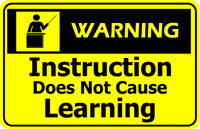In a perfect world, we’d all create software and websites and knowledgebases and blogs and videos and e-learning and such that would be posted and then never be opened up to the most evil and destructive beings on the planet.
Users.
 Our work would shine brightly, with buttons and links perfectly aligned, un-clicked and never seen, so that we’d never have to hear those annoying whining noises. “I can’t make it do this” and “It won’t do that” and “It doesn’t have any of those” keep echoing in our heads at night, as we try to sleep. Don’t they know that we’ve created perfection?
Our work would shine brightly, with buttons and links perfectly aligned, un-clicked and never seen, so that we’d never have to hear those annoying whining noises. “I can’t make it do this” and “It won’t do that” and “It doesn’t have any of those” keep echoing in our heads at night, as we try to sleep. Don’t they know that we’ve created perfection?
Users!
You can’t live with ‘em. And you can’t kill ‘em, chop ‘em up, wrap ‘em in paper, and UPS ‘em to random people from your phone directory. (At least according to last week’s version of “CSI: New York” you can’t.)
So what’s a poor coder to do?
You might think about doing a little usability testing. It’s not really that hard, and if you integrate it from the beginning of your project it can really improve the final product. The problem is that you (and your little Red Bull drinking buddies) really aren’t the target users. You know too much about whatever it is that your software does. So you’ll need to buy a couple of pizzas for a user group, show them some mock-ups, and then SHUT THE HELL UP as they try to complete some simple activities.
Video tape the action, and then bring it back to deconstruct. Work a little further, and repeat. And repeat. And repeat.
Don’t know how to do a simple UI review? Point your mousie over to http://www.useit.com and listen to Jakob Nielsen, the God of web design. Do what he says.
Or hire an expert. There are lots of good people available to hold your hand and make sure what you’re developing actually works for the poor fools who give you money.
Then you can buy more Red Bull, games, and a membership on Match.com. Maybe even move out of Mom’s basement.

 That’s how learning happens in the best systems. We create “goals” (temperature limits) and constantly keep making “assessments” (measurements) of how we’re doing in reaching those goals. So there’s no real surprise at 10PM each night — we know already whether it’s been hot or cold, and we’ve taken action to change what we’re doing based on that.
That’s how learning happens in the best systems. We create “goals” (temperature limits) and constantly keep making “assessments” (measurements) of how we’re doing in reaching those goals. So there’s no real surprise at 10PM each night — we know already whether it’s been hot or cold, and we’ve taken action to change what we’re doing based on that. of success that were stored away in the carefully moussed head of an amazingly handsome and talented young man who knew way more than we did. I had looked forward to the opportunity to improve my skills, to understand how he had succeeded when so many others had failed, and to leave that morning with lots of ideas on how to make things happen.
of success that were stored away in the carefully moussed head of an amazingly handsome and talented young man who knew way more than we did. I had looked forward to the opportunity to improve my skills, to understand how he had succeeded when so many others had failed, and to leave that morning with lots of ideas on how to make things happen. training. In most tough economic times, the training department is usually one of the first to feel the knife — there’s an assumption that people can just learn on the job, or that they really don’t need to travel to those expensive seminars.
training. In most tough economic times, the training department is usually one of the first to feel the knife — there’s an assumption that people can just learn on the job, or that they really don’t need to travel to those expensive seminars.